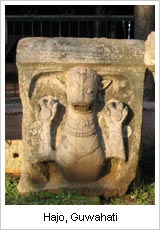Introduction:
The city Guwahati, derives its name from
two Assamese words, 'Guwa' meaning a chewable betel nut and
'Haat' meaning Market. Set amidst the scenic hills of the
eastern Himalayas, Guwahati is well known for its sprawling
tea gardens and the place has emerged as one of the largest
tea-auctioning center in the world. Guwahati is referred as
the 'Gateway to the Northeast', as all the seven northeastern
states of India are easily accessible from here. Guwahati
is also an important place of Hindu pilgrimage and the place
is popular for its unique, vivid and colorful culture. Guwahati
is also famous for its colorful festivals such as Majuli Festival
(21-24 November), Elephant Festival (11-17 February), Dehing
Patkai Festival (16-19 January), Tea Festival, Bohag Bihu
(April) and Rangoli Utsav (28 -30 April). Guwahati also offers
exciting shopping experience to its visitors.
Apart from its exceptional scenic beauty and fascinating culture,
there are several tourist attractions in Guwahati. The major
tourist attractions of Guwahati include the famous Kamakhya
Temple, Vashistha Ashram, Guwahati Tea Auction Center, Guwahati
Zoo, Dol Gobinda, Gandhi Mandap, Forest Museum, Anthropological
Museum and Guwahati Planetarium.
How to Reach
By Air: Guwahati is an important airport
in the region. There are regular flights to Guwahati from
Delhi, Calcutta, Imphal, Agartala, Aizawl, Dibrugarh and Jorhat.
By Rail: Guwahati is the headquarters of
the Northeast Frontier Railway and so is well connected by
Rail with the rest of the country.
By Road: Guwahati has a well-developed road
networks and is the most important hub for road transport
in the region. Assam State Transport Corporation buses connect
it to neighboring towns of Shillong, Tezpur, Silchar, Cooch
Behar, Aizawl, Dibrugarh, Imphal and Agartala. |
|
 |

